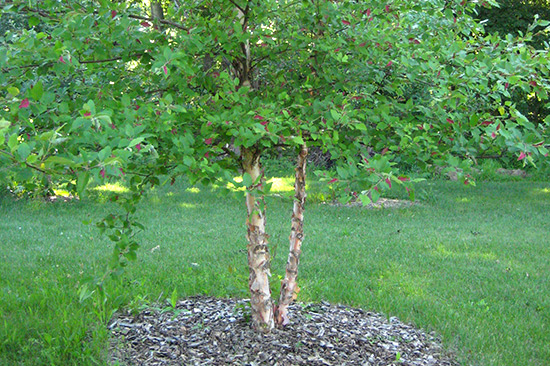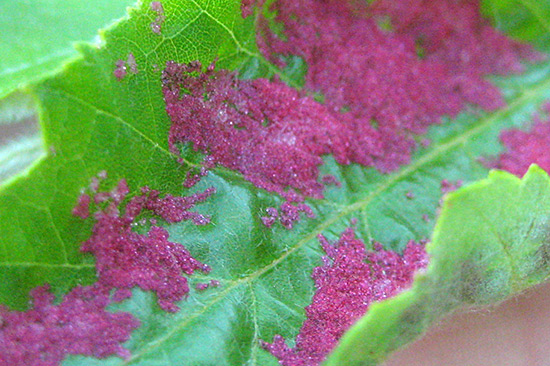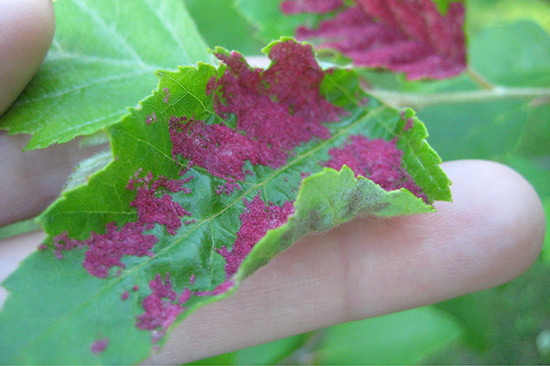While visiting my sister’s family, we took a stroll (as I often ask to) around the landscape. They’ve owned their home for a little over a year now. The variety of previously installed trees and plants are plentiful, though placement has at times left us scratching our heads. One of the trees on the property is a River Birch (Betula nigra). As we approached the tree, I noticed something odd about the leaves.

Why are my river birch leaves covered in pink velvet?
A lot of people would immediately assume the tree is sick, buy a pesticide, and douse the tree in hopes of saving it. Mature trees cost quite a pretty penny to replace in a landscape. However, the more economical and ecologically-safe way to handle the situation is to first identify what is going on with the plant. It doesn’t make much sense to take a round of steriods if all you have is a chipped fingernail, right?
Even though my sister wasn’t sure if the pink areas meant the birch tree was diseased, she was on the right track by asking questions. What was this pink fuzz? What causes it? Was there any need to worry about the tree’s health? So began our sleuthing…
Clues to Determine Plant Disease
First we would need to identify the type of tree we were examining, which we already knew. The River Birch is a native to the Eastern United States, loves acidic soils, is at home in wet ground, and is one of the few heat-tolerant birches. It also has a beautiful, self-exfoliating bark which makes it a highly sought after landscape tree.
Next, we pulled some branches down toward us to take a closer look at the top side of the river birch’s leaves. The surface of the birch leaves were covered in what appeared to be a pink fuzz. The leaves were not chewed up and there weren’t visible insects present on the top or bottom of the leaves.
Next, it was to The Internets to find the culprit! Usually, university websites are most reliable when trying to identify plant pests and diseases. With the tree’s name and a description of it’s affliction, I was able to solve the mystery of the pink fuzz and what caused it.
Erineum Gall
According to the University of Minnesota Extension site, “galls are formed by insect/mite feeding or egg-laying activity.” Galls are plant cells that have increased in size or number due to the insect or mite. Further reading categorizes galls into leaf galls, stem and twig galls, and bud / flower galls. The pink fuzz is a type of leaf gall, specifically a Erineum Gall as those are characterized by “(hairy felt-like growths) on the upper or lower leaf surface.”
What Causes Erineum Galls on River Birch?
The Mississippi State University Extension site points out that galls are host-specific. More digging around found articles on the University of Minnesota and the Wisconsin Department of Agriculture site identifying eriophyid mites as the cause of erineum galls on river birch. The Ohio State University Extension site goes further to identify the mite A. brevitarsus as the eriophyid mite that “generates pinkish-red erineum patches on the upper leaf surface of birch leaves.” These tiny mites overwinter on the tree and begin feeding on the plant tissue in the spring when the tree leafs out.
Are eriphyid mites harmful to the river birch? All state extensions sites I referenced had the same answer; “no.” The mites do not effect the overall health of the river birch and often the damage is purely cosmetic.
Pest Control for Eriophyid Mites
When I find a pest or disease on a plant to be purely cosmetic, most of the time I just let it run its course. According to the Missouri Botanical Garden site, the use of a miticide could kill predator mites as well and worsen the outbreak. Many chemical treatments do not work because precise timing of applications is needed before mite activity begins. By the time the erineum galls are visible on birch trees, there is no effective treatment (chemical or otherwise) to control the mites since they are protected by the galls.

If the landscape owner feels it is absolutely necessary to try to control the eriophyid mites, The University of Minnesota Extension site recommends applying a horticultural oil at bud break right before mite activity begins.

